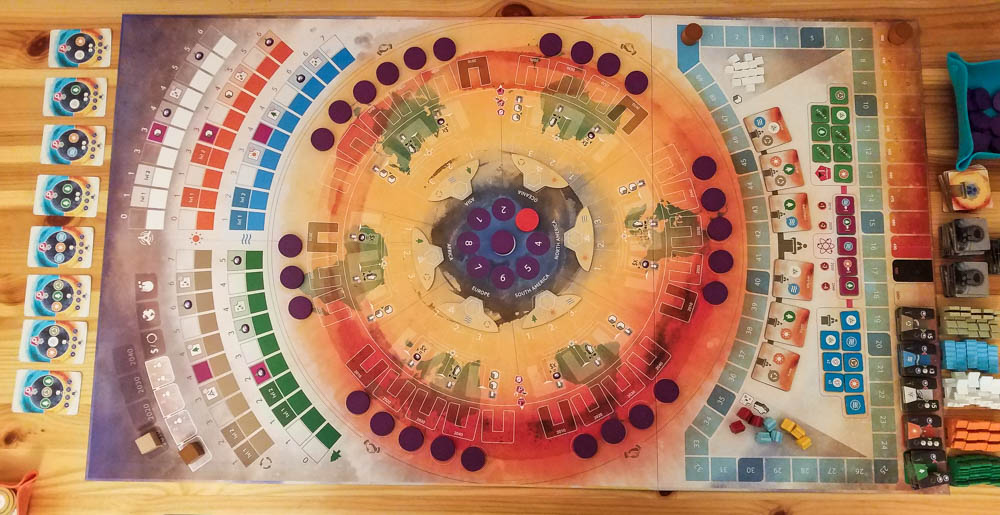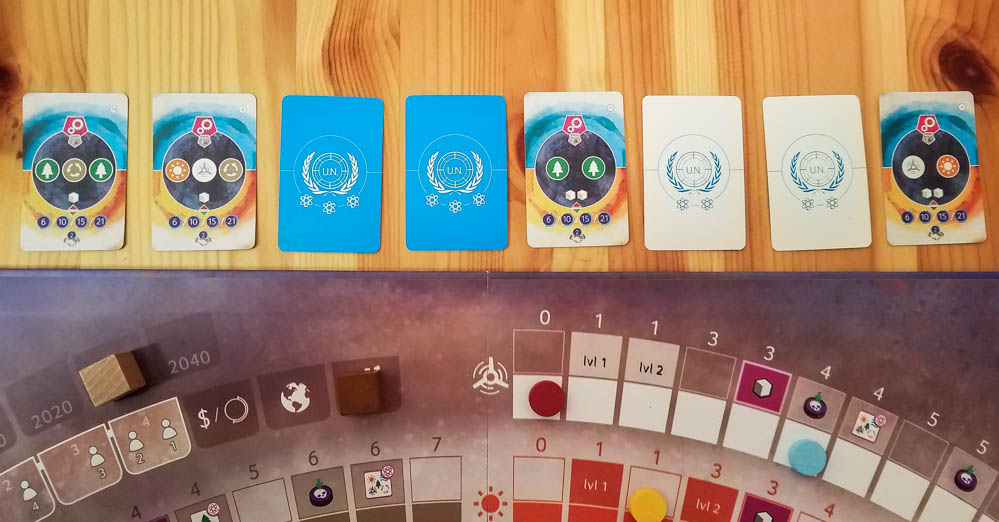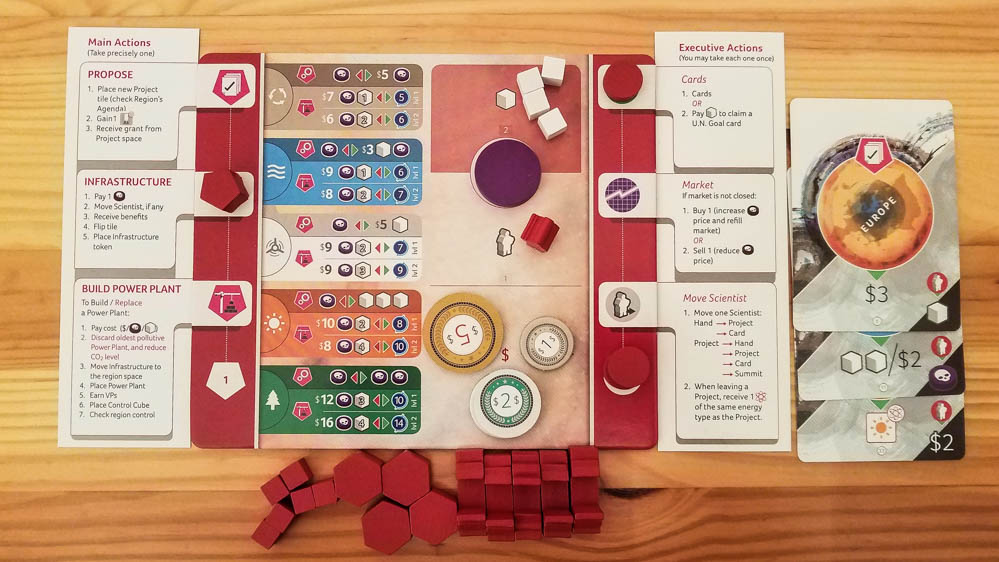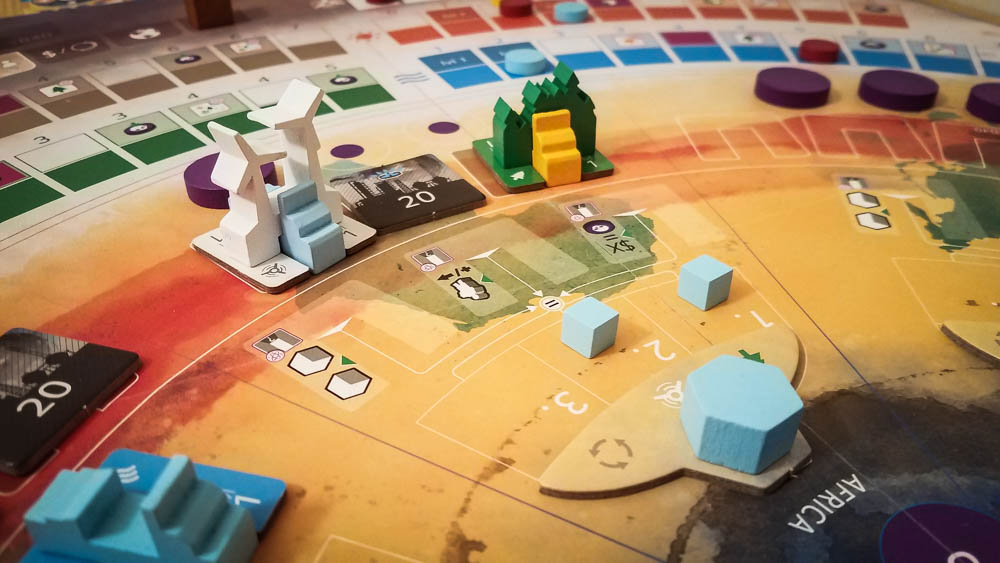CO₂: Second Chance Review

Year: 2019 | Players: 1-4 | Minutes: 60+ | Ages: 12+
This CO₂: Second Chance review was made after playing the game five times (four co-op, one competitive). We were sent a copy of this game by the publisher in exchange for an honest review.
What is CO₂: Second Chance?
CO₂: Second Chance is a game in which you are CEOs of energy companies who are attempting to keep pollution levels down by building green power plants around the globe. The game comes with a double-sided board; one side for cooperative play and the other for competitive play.
CO₂: Second Chance was designed by Vital Lacerda and is published by Stronghold Games.
Rules Overview
In CO₂: Second Chance you control an energy company that is working to keep the planet’s carbon dioxide levels down. Over a number of decades–four in co-op, five in competitive–you’ll be attempting to build green energy plants while also trying to profit as a company. In the co-op game your companies are working together to gain victory points as a team, while in the competitive/semi-cooperative game you’re trying to end up with the most victory points.
There are six regions that you’ll be building power plants in and five types of plants: Recycling, Hydro, Wind, Solar, and Forestation. Each region only accepts three of the five types of plants, which is randomized each game. These regions also provide different amounts of Carbon Emission Permits (CEPs), which you’ll need when you want to build your power plants.
Each player starts the game with five Lobbyist cards and two Private Goal cards. The Lobbyist cards allow you to either get bonuses by taking certain actions during your turns (Main effect) or you can play them for their minor benefits. These cards also become worker placement spots that you or someone else can use later in the game. In the co-op game, everyone has to complete one of their two private goals, while in the competitive game they can be completed for victory points or discarded at any point for $8. No one can talk about the cards in their hands in either game mode.
Each turn you’ll be taking one of three Main actions, each representing part of the process of putting up a power plant. You’ll first need to propose a project, then infrastructure can be placed in that spot, and then finally a plant can be built. When you propose a project, the region gives you a grant based on where you build, such as money equal to the number of CEPs the region currently has. When you prepare infrastructure, you’ll get a reward based on the type of project it is and you’ll get to place one of your infrastructure tokens onto that tile. Finally, when you build a plant, you’ll pay the cost of the plant, place the matching plant on top of the infrastructure, get victory points based on the type of plant you built, and then possibly gain control of that region’s energy supply (giving you access to their CEPs).
You’ll usually be focusing on the available U.N. Goal cards. Each card has two or three different types of power plants shown and to claim a card you need to have infrastructure in built plants of the shown types. In the co-op game, your group needs to have all but three of the U.N. Goal cards claimed/flipped in order to win. In the competitive game, you’ll get victory points based on the number of U.N. Goal cards you have in front of you at the end of the game.
You can also perform one, two, or all three of the Executive actions on your turn. You can play a Lobbyist card or claim a U.N. Goal card, you can move one of your scientists, or you can buy/sell CEPs on the CEP Market.
Your scientists’ main job is to gain knowledge to help your company learn about the different energy types. They gain knowledge by working on projects and by attending different energy summits. As your company moves higher up the knowledge tracks, you’ll get bonuses such as the tech cubes you’ll need to complete U.N. Goal cards.
After everyone has taken their turns, you’ll receive income based on where you are on the different knowledge tracks. You get to choose how much income you receive as victory points and how much you receive as money.
In the co-op game, there are a bunch of environmental goals that you’re trying to complete as a team. You complete them by building plants, getting your knowledge tracks to certain levels, and by sending your scientists to different energy summits. You’ll lose points for every goal you haven’t completed at the end of each decade, and the amount of victory points you’ll lose increases every decade. There’s also a U.N. Inspectors variant that makes some goals more important than others; we always play with this variant.
The environmental goals are replaced by Event tiles in the competitive game. These tiles tell you where the events are going to happen. Anyone that doesn’t have infrastructure or power plants in those regions will have to pay a CEP and a tech cube at the end of the round.
The Energy Supply phase is the last phase of each round in the co-op game and the first phase in the competitive game. This is when you check if each region has had a power plant built for the current decade. For every region that doesn’t have a plant, the region is forced to build a fossil fuel plant, which increases the global pollution levels by varying amounts. In the co-op game you want to keep the CO₂ levels at 500 ppm or lower, but you can give up victory points to lower it at the end of the round even if it goes over 500 ppm temporarily. In the competitive game everyone instantly loses if the CO₂ levels ever exceed 500 ppm.
You’ll beat the co-op game if your group is able to make it through all four decades, there are three or fewer U.N. Goal cards remaining, and everyone has completed one of their private goals. There’s also a Victory Epithet card that will tell you exactly how well you did based on how many U.N. Cards you’ve claimed as a team and how many victory points you have. You’ll win the competitive game if you end up with the most victory points.
Hopefully that gives you an idea of how the game plays. You’ll try to get some bonuses from your Lobbyist cards, you’ll want to send your scientists out to increase your company’s knowledge in different areas, and you’ll want to work on the power plants that help you claim those U.N. Goal cards.
Check out the CO₂: Second Chance rulebook at BGG.
Check out our Top 10 Family Games!
Pros and Cons
Pros
- I really like this theme and I think it works for both game modes. In the competitive game you all want to work together to keep the pollution levels down, but you also want to have the most successful company. In the cooperative game the pollution situation is quite a bit worse and you have to work together to make sure it doesn’t get completely out of hand.
- I’m all about satisfying moments in games, and there are a bunch of those in CO₂: Second Chance. It feels great when you’ve done enough to keep the pollution levels down at the end of each decade, and it feels even better when you find a way to claim those U.N. Goal cards.
- Every single decision you make in this game is important. You only get one of those Main actions per turn, so it definitely does matter where you decide to work on your projects.
- Even though you can’t talk about the cards in your hand in the co-op game, there is still plenty of cooperation. Sometimes you want to focus on your own plants, but often you want to check what your teammates are working on and get a project set up for them.
- Unlike just about all other co-ops, most of the in-game adjustments you make in CO₂: Second Chance are to the other players’ moves rather than to the game itself. That makes sense thematically and it makes this feel like a very unique puzzle.
- You can pull off some pretty sweet combos in this game. For example, you can send your scientist to a project and in the same turn prepare infrastructure for that project so the scientist gains knowledge and possibly activates a bonus on that knowledge track.
- Area control is another cool part of the game, especially in the three and four-player competitive games. You want access to the regions’ CEPs, so you might sometimes decide to build in a region specifically because you can gain control of its energy supply. It adds in a whole other level of strategy.
- The power plants look great once they’re all set up. I actually like the look of just about everything in this game, but the plants definitely bring it all together.
- The puzzle, while pretty static once the game begins, is different from game to game. You’ll have different private goals, different Lobbyist cards, the environmental goals are randomized, and the regions will take different types of power plants every game.
- While CO₂: Second Chance is a pretty complex game, I actually found it easy to learn and teach. The rulebook is excellent (plenty of examples!) and it’s one of those board games you can teach as you play.
- The player boards and player aids definitely do help new players. They list all of your available actions and they have a complete list of costs for all of the different types of power plants.
Cons
- I think the main complaint that most people will have is with some of the misprints on the cards, on the tiles, on the board, and in the rulebook. The most noticeable is the fact that the year “2050” isn’t shown on the project areas in each region on the competitive side of the board. The U.N. Goal cards are also printed upside down, but I didn’t even notice that until I read about them. To be honest, none of that stuff ruined my group’s experience in any way, but I do understand why it’s a problem for some people.
- The U.N. Goals are obviously a very important part of this game, which is why I don’t like that they’re on cards that go on the side of the board. I wish they had found a way to include spots for them on the board, maybe as tokens instead of as cards.
- You need a pretty large table to play CO₂: Second Chance comfortably. The board is huge and you need even more room for your player boards, your played cards, and all of the extra components.
- There definitely can be some feel-bad moments in the competitive game. If you’re trying to set up a plant so you can complete a U.N. goal and someone else puts their infrastructure in that spot, yeah, you might get mad. That can happen in the co-op game, too, but it’s a lot more common in the competitive game.
- It does take a while to set this game up and put it away.
Final Thoughts
CO₂: Second Chance is different than anything my group has ever played and it’s just awesome. The theme is unique, it looks great on the table, the two game modes are both fun to play, and it’s challenging without being frustrating. Plus, as I pointed out earlier, it creates a bunch of very satisfying moments each game and every decision you make feels important.
The only people I wouldn’t recommend CO₂: Second Chance to are those who aren’t fans of mathy games and those who don’t find this theme interesting. To everyone else, yeah, definitely check this one out. Even if you’re only interested in playing one of the two game modes, it’s still worth getting.
- Update: CO₂: Second Chance made it onto the Best Cooperative Board Games of 2019 list!
CO₂: Second Chance Links
BGG | Miniature Market
Thanks for taking the time to read our CO₂: Second Chance review!
Be sure to also take a look at our Best Cooperative Board Games list and other rankings.
To stay updated on all things co-op board games and card games, follow us on Facebook and X.




